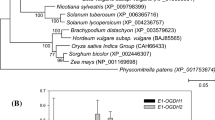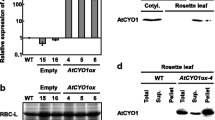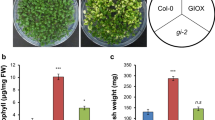Abstract
Main conclusion
T-protein is present in large excess over the other proteins of the glycine cleavage system in leaves of Arabidopsis and therefore, exerts little control over the photorespiratory pathway.
T-protein is the aminomethyltransferase of the glycine cleavage multienzyme system (GCS), also known as the glycine decarboxylase complex, and essential for photorespiration and one-carbon metabolism. Here, we studied what effects varying levels of the GCS T-protein would have on GCS activity, the operation of the photorespiratory pathway, photosynthesis, and plant growth. To this end, we examined Arabidopsis thaliana T-protein overexpression lines with up to threefold higher amounts of leaf T-protein as well as one knockdown mutant with about 5% residual leaf T-protein and one knockout mutant. Overexpression did not alter photosynthetic CO2 uptake and plant growth, and the knockout mutation was lethal even in the non-photorespiratory environment of air enriched to 1% CO2. Unexpectedly in light of this very low T-protein content, however, the knockdown mutant was able to grow and propagate in normal air and displayed only some minor changes, such as a moderate glycine accumulation in combination with somewhat delayed growth. Neither overexpression nor the knockdown of T-protein altered the amounts of the other three GCS proteins, suggesting that the biosynthesis of the GCS proteins is not synchronized at this level. We also observed that the knockdown causes less T-protein mostly in leaf mesophyll cells, but not so much in the vasculature, and discuss this phenomenon in light of the dual involvement of the GCS and hence T-protein in plant metabolism. Collectively, this work shows that T-protein is present in large excess over the other proteins of the glycine cleavage system in leaves of Arabidopsis and therefore exerts little control over the photorespiratory pathway.






Similar content being viewed by others
Abbreviations
- GCS:
-
Glycine cleavage system
- HC:
-
High-CO2 conditions
- LC:
-
Low-CO2 conditions
- SHMT:
-
Serine hydroxymethyltransferase
- THF:
-
Tetrahydrofolate
References
Alonso JM, Stepanova AN, Leisse TJ, Kim CJ, Chen H, Shinn P, Stevenson DK, Zimmerman J, Barajas P, Cheuk R, Gadrinab C, Heller C, Jeske A, Koesema E, Meyers CC, Parker H, Prednis L, Ansari Y, Choy N, Deen H, Geralt M, Hazari N, Hom E, Karnes M, Mulholland C, Ndubaku R, Schmidt I, Guzman P, Aguilar-Henonin L, Schmid M, Weigel D, Carter DE, Marchand T, Risseeuw E, Brogden D, Zeko A, Crosby WL, Berry CC, Ecker JR (2003) Genome-wide insertional mutagenesis of Arabidopsis thaliana. Science 301:653–657
Bauwe H, Hagemann M, Fernie AR (2010) Photorespiration: players, partners and origin. Trends Plant Sci 15:330–336
Blackwell RD, Murray AJS, Lea PJ (1990) Photorespiratory mutants of the mitochondrial conversion of glycine to serine. Plant Physiol 94:1316–1322
Boyes DC, Zayed AM, Ascenzi R, McCaskill AJ, Hoffman NE, Davis KR, Gorlach J (2001) Growth stage-based phenotypic analysis of Arabidopsis: a model for high throughput functional genomics in plants. Plant Cell 13:1499–1510
Bradford MM (1976) A rapid and sensitive method for the quantitation of microgram quantities of protein utilizing the principle of protein-dye binding. Anal Biochem 72:248–254
Clough SJ, Bent AF (1998) Floral dip: a simplified method for Agrobacterium-mediated transformation of Arabidopsis thaliana. Plant J 16:735–743
Douce R, Bourguignon J, Neuburger M, Rebeille F (2001) The glycine decarboxylase system: a fascinating complex. Trends Plant Sci 6:167–176
Engel N, van den Daele K, Kolukisaoglu Ü, Morgenthal K, Weckwerth W, Pärnik T, Keerberg O, Bauwe H (2007) Deletion of glycine decarboxylase in Arabidopsis is lethal under non-photorespiratory conditions. Plant Physiol 144:1328–1335
Engel N, Eisenhut M, Qu N, Bauwe H (2008) Arabidopsis mutants with strongly reduced levels of the T-protein subunit of glycine decarboxylase. In: Allen JF, Gantt E, Golbeck JH, Osmond CB (eds) Photosynthesis. Energy from the Sun: 14th international conference of photosynthesis, vol 1. Springer, Dordrecht, pp 819–822
Engel N, Ewald R, Gupta KJ, Zrenner R, Hagemann M, Bauwe H (2011) The presequence of Arabidopsis serine hydroxymethyltransferase SHM2 selectively prevents import into mesophyll mitochondria. Plant Physiol 157:1711–1720
Fan J, Ye J, Kamphorst JJ, Shlomi T, Thompson CB, Rabinowitz JD (2014) Quantitative flux analysis reveals folate-dependent NADPH production. Nature 510:298–302
Fernie AR, Aharoni A, Willmitzer L, Stitt M, Tohge T, Kopka J, Carroll AJ, Saito K, Fraser PD, DeLuca V (2011) Recommendations for reporting metabolite data. Plant Cell 23:2477–2482
Foyer CH, Bloom AJ, Queval G, Noctor G (2009) Photorespiratory metabolism: genes, mutants, energetics, and redox signaling. Annu Rev Plant Biol 60:455–484
Hanson AD, Roje S (2001) One-carbon metabolism in higher plants. Annu Rev Plant Physiol Plant Mol Biol 52:119–137
Häusler RE, Kleines M, Uhrig H, Hirsch H-J, Smets H (1999) Overexpression of phosphoenolpyruvate carboxylase from Corynebacterium glutamicum lowers the CO2 compensation point (Γ *) and enhances dark and light respiration in transgenic potato. J Exp Bot 50:1231–1242
Heineke D, Bykova N, Gardeström P, Bauwe H (2001) Metabolic response of potato plants to an antisense reduction of the P-protein of glycine decarboxylase. Planta 212:880–887
Keech O, Dizengremel P, Gardeström P (2005) Preparation of leaf mitochondria from Arabidopsis thaliana. Physiol Plant 124:403–409
Kikuchi G, Motokawa Y, Yoshida T, Hiraga K (2008) Glycine cleavage system: reaction mechanism, physiological significance, and hyperglycinemia. Proc Japan Acad Ser B Phys Biol Sci 84:246–263
Kisaki T, Tolbert NE (1970) Glycine as substrate for photorespiration. Plant Cell Physiol 11:247–258
Kopriva S, Turner SR, Rawsthorne S, Bauwe H (1995) T-protein of the glycine decarboxylase multienzyme complex: evidence for partial similarity to formyltetrahydrofolate synthetase. Plant Mol Biol 27:1215–1220
Li R, Moore M, King J (2003) Investigating the regulation of one-carbon metabolism in Arabidopsis thaliana. Plant Cell Physiol 44:233–241
Lisec J, Schauer N, Kopka J, Willmitzer L, Fernie AR (2006) Gas chromatography mass spectrometry-based metabolite profiling in plants. Nat Protoc 1:387–396
Motokawa Y, Kikuchi G (1974) Glycine metabolism by rat liver mitochondria. Reconstitution of the reversible glycine cleavage system with partially purified protein components. Arch Biochem Biophys 164:624–633
Murchie EH, Lawson T (2013) Chlorophyll fluorescence analysis: a guide to good practice and understanding some new applications. J Exp Bot 64:3983–3998
Neuburger M, Bourguignon J, Douce R (1986) Isolation of a large complex from the matrix of pea leaf mitochondria involved in the rapid transformation of glycine into serine. FEBS Lett 207:18–22
Oliver DJ (1994) The glycine decarboxylase complex from plant mitochondria. Annu Rev Plant Physiol Plant Mol Biol 45:323–337
Oliver DJ, Neuburger M, Bourguignon J, Douce R (1990) Interaction between the component enzymes of the glycine decarboxylase multienzyme complex. Plant Physiol 94:833–839
Palmer AC, Egan JB, Shearwin KE (2011) Transcriptional interference by RNA polymerase pausing and dislodgement of transcription factors. Transcription 2:9–14
Rajinikanth M, Harding SA, Tsai CJ (2007) The glycine decarboxylase complex multienzyme family in Populus. J Exp Bot 58:1761–1770
Rebeille F, Neuburger M, Douce R (1994) Interaction between glycine decarboxylase, serine hydroxymethyltransferase and tetrahydrofolate polyglutamates in pea leaf mitochondria. Biochem J 302:223–228
Sagers RD, Gunsalus IC (1961) Intermediary metabolism of Diplococcus glycinophilus. I. Glycine cleavage and one-carbon interconversion. J Bacteriol 81:541–549
Schjoerring JK, Mäck G, Nielsen KH, Husted S, Suzuki A, Driscoll S, Boldt R, Bauwe H (2006) Antisense reduction of serine hydroxymethyltransferase results in diurnal displacement of NH4 + assimilation in leaves of Solanum tuberosum. Plant J 45:71–82
Sharkey TD (1988) Estimating the rate of photorespiration in leaves. Physiol Plant 73:147–152
Simkin AJ, Lopez-Calcagno PE, Davey PA, Headland LR, Lawson T, Timm S, Bauwe H, Raines CA (2017) Simultaneous stimulation of sedoheptulose 1,7-bisphosphatase, fructose 1,6-bisphosphate aldolase and the photorespiratory glycine decarboxylase H-protein increases CO2 assimilation, vegetative biomass and seed yield in Arabidopsis. Plant Biotechnol J 15:805–816
Stockhaus J, Schell J, Willmitzer L (1989) Correlation of the expression of the nuclear photosynthetic gene ST-LS1 with the presence of chloroplast. EMBO J 8:2445–2451
Timm S, Florian A, Arrivault S, Stitt M, Fernie AR, Bauwe H (2012) Glycine decarboxylase controls photosynthesis and plant growth. FEBS Lett 586:3692–3697
Timm S, Florian A, Wittmiss M, Jahnke K, Hagemann M, Fernie AR, Bauwe H (2013) Serine acts as a metabolic signal for the transcriptional control of photorespiration-related genes in Arabidopsis. Plant Physiol 162:379–389
Timm S, Wittmiss M, Gamlien S, Ewald R, Florian A, Frank M, Wirtz M, Hell R, Fernie AR, Bauwe H (2015) Mitochondrial dihydrolipoyl dehydrogenase activity shapes photosynthesis and photorespiration of Arabidopsis thaliana. Plant Cell 27:1968–1984
Vauclare P, Diallo N, Bourguignon J, Macherel D, Douce R (1996) Regulation of the expression of the glycine decarboxylase complex during pea leaf development. Plant Physiol 112:1523–1530
Walker JL, Oliver DJ (1986) Glycine decarboxylase multienzyme complex. Purification and partial characterization from pea leaf mitochondria. J Biol Chem 261:2214–2221
Waller JC, Alvarez S, Naponelli V, Lara-Nuñez A, Blaby IK, Da Silva V, Ziemak MJ, Vickers TJ, Beverley SM, Edison AS, Rocca JR, Gregory JF, de Crécy-Lagard V, Hanson AD (2010) A role for tetrahydrofolates in the metabolism of iron-sulfur clusters in all domains of life. Proc Natl Acad Sci USA 107:10412–10417
Waller JC, Ellens KW, Alvarez S, Loizeau K, Ravanel S, Hanson AD (2012) Mitochondrial and plastidial COG0354 proteins have folate-dependent functions in iron-sulphur cluster metabolism. J Exp Bot 63:403–411
Wiludda C, Schulze S, Gowik U, Engelmann S, Koczor M, Streubel M, Bauwe H, Westhoff P (2012) Regulation of the photorespiratory GLDPA gene in C4 Flaveria: an intricate interplay of transcriptional and posttranscriptional processes. Plant Cell 24:137–151
Wingler A, Lea PJ, Leegood RC (1997) Control of photosynthesis in barley plants with reduced activities of glycine decarboxylase. Planta 202:171–178
Wingler A, Quick WP, Bungard RA, Bailey KJ, Lea PJ, Leegood RC (1999) The role of photorespiration during drought stress: an analysis utilizing barley mutants with reduced activities of photorespiratory enzymes. Plant Cell Environ 22:361–373
Winzer T, Heineke D, Bauwe H (2001) Growth and phenotype of potato plants expressing an antisense gene of P-protein of glycine decarboxylase under control of a promoter with preference for the mesophyll. Ann Appl Biol 138:9–15
Woody ST, Austin-Phillips S, Amasino RM, Krysan PJ (2007) The WiscDsLox T-DNA collection: an arabidopsis community resource generated by using an improved high-throughput T-DNA sequencing pipeline. J Plant Res 120:157–165
Acknowledgements
We wish to thank Piotr Bociag and Kathrin Jahnke (both Rostock) for technical assistance and the Nottingham Arabidopsis Stock Centre for the T-DNA insertional lines. This work was financially supported by the Deutsche Forschungsgemeinschaft (Research Unit FOR 1186 Promics, BA 1177/12-2 and FE 552/10-2).
Author information
Authors and Affiliations
Corresponding author
Electronic supplementary material
Below is the link to the electronic supplementary material.
Rights and permissions
About this article
Cite this article
Timm, S., Giese, J., Engel, N. et al. T-protein is present in large excess over the other proteins of the glycine cleavage system in leaves of Arabidopsis. Planta 247, 41–51 (2018). https://doi.org/10.1007/s00425-017-2767-8
Received:
Accepted:
Published:
Issue Date:
DOI: https://doi.org/10.1007/s00425-017-2767-8




